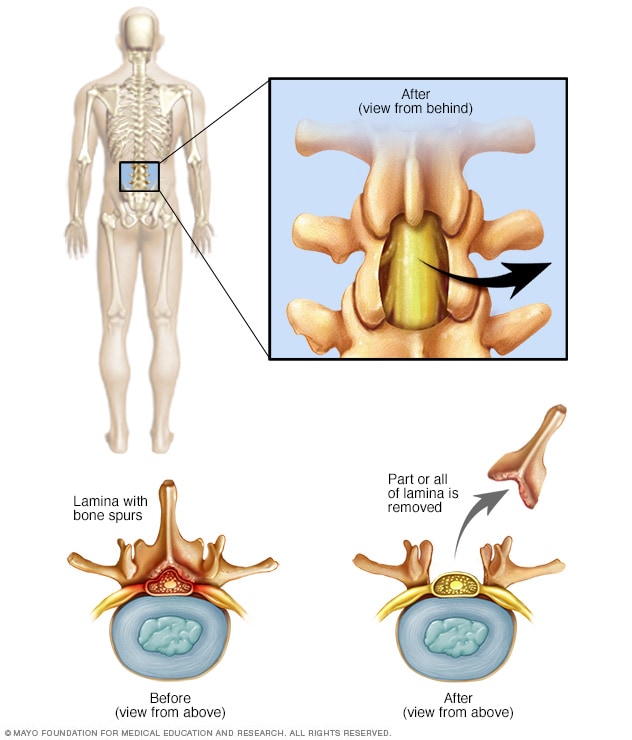Why it's done
Bony overgrowths of the joints in the spine can build up within the spinal canal. They can narrow the space for the spinal cord and nerves. This pressure can cause pain, weakness or numbness that can radiate down arms or legs.
Because laminectomy restores spinal canal space, it's likely to relieve the pressure that causes the radiating pain. But the procedure doesn't cure the arthritis that caused the narrowing. So, it's not likely to relieve back pain.
A health care provider might recommend laminectomy if:
- Conservative treatment, such as medication or physical therapy, fails to improve symptoms
- Muscle weakness or numbness makes standing or walking difficult
- Symptoms include loss of bowel or bladder control
-
How you prepare
You'll need to avoid eating and drinking for a certain amount of time before surgery. Your health care provider can give you instructions about the types of medications you should and shouldn't take before your surgery.

-
What you can expect
During laminectomy
Surgeons usually perform laminectomy using general anesthesia, so you're unconscious during the procedure.
The surgical team monitors heart rate, blood pressure and blood oxygen levels throughout the procedure. After you are unconscious and can't feel pain:
- The surgeon makes an incision in your back over the affected vertebrae and moves the muscles away from your spine as needed. The surgeon uses small instruments to remove the bone spurs and the smallest amount of lamina necessary. The size of the incision may vary depending on your condition and body size. Minimally invasive surgeries typically use smaller incisions than those used for open procedures.
- If laminectomy is being performed as part of surgical treatment for a herniated disk, the surgeon also removes the herniated portion of the disk and any pieces that have broken loose (diskectomy).
- For a vertebra that has slipped over another or for curvature of the spine, spinal fusion might be needed to stabilize the spine. During spinal fusion, the surgeon permanently joins two or more of the vertebrae after removing the arthritic joints. The surgery might involve the use of bone grafts and, if necessary, metal rods and screws.
- Depending on your condition and your needs, the surgeon may use a smaller (minimally invasive) incision and a special surgical microscope to perform the operation.
After laminectomy
After surgery, you're moved to a recovery room where the health care team watches for complications from the surgery and anesthesia. You may also be asked to move your arms and legs. Your health care provider may prescribe medication to relieve pain at the incision site.
You're likely to spend a night or two in the hospital. Your provider might recommend physical therapy after a laminectomy to improve your strength and flexibility.
Depending on the amount of lifting, walking and sitting your job involves, you may be able to return to work within a few weeks. If you also have spinal fusion, your recovery time will be longer.


